Thanksgiving a good time to reflect on wild turkey?s comeback
By CASEY WARNER
Marketing and Outreach Division
Michigan Department of Natural Resources
Hearing wild turkeys gobbling and clucking as you step out into the backyard early in the morning is common for many Michiganders now, but it wasn?t always so.
As we mark the annual holiday that revolves around turkey, let?s look back and celebrate these birds? remarkable return from near extinction, often called one of the country?s greatest wildlife conservation success stories.
There are more than 6 million wild turkeys in the United States today, but seeing ? or hearing ? one was rare as recently as 50 years ago.
In Michigan, wild turkeys had been plentiful prior to the arrival of settlers, with an estimated 94,000 in the state at that time.
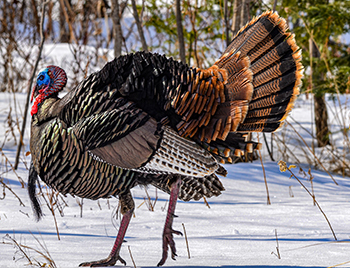
By the 1950s, Michigan?s wild turkey population had disappeared due to unregulated hunting and habitat loss.
Bringing turkeys back from the brink
Thanks to the efforts of a committed cadre of conservationists over the last 70 years, 200,000 wild turkeys now call Michigan home. They can be found in parts of every Lower Peninsula county and areas of the Upper Peninsula.
By 1965, the turkey population had rebounded enough that hunting was allowed. Today Michigan ranks sixth in the nation for number of turkey hunters, with consistently high hunter success and satisfaction rates.
Michigan?s spring turkey season is open in every county, and fall hunting is open in many areas of the state.
?We?ve gone from extirpation of all wild turkeys in Michigan to today we have over 200,000 birds and you can hunt turkeys in every county in the state,? said Al Stewart, who retired last year after a 50-year career working in wildlife management for the Michigan Department of Natural Resources, 20 of those years as the DNR?s upland game bird specialist.
|
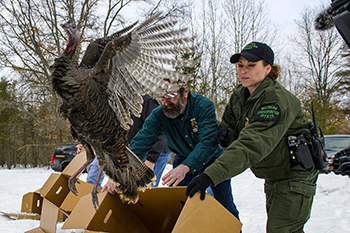
?It has brought so much pleasure and enjoyment to people either in viewing wild turkeys and knowing they were there or the ability to hunt in both the spring and fall.?
Early wild turkey restoration attempts in Michigan using hatchery programs failed because the turkeys raised still behaved like domesticated birds, weren?t equipped to live in the wild and succumbed to disease, predators and weather.?
In the 1950s, the Michigan Department of Conservation (now the DNR) purchased 50 wild turkeys from Pennsylvania and released them in West Michigan.
Stewart was part of a later effort to reintroduce the birds. In 1983 he, along with many others, brought wild turkeys to Michigan from Iowa and Missouri and established some flocks in the southern part of the state. He was in charge of teaching DNR staff how to trap offspring of those birds to then move them to other locations in the state to help expand this restoration activity.
Ongoing efforts
Since the 1980s, the DNR has worked with many partners to complete numerous releases of trapped wild birds and improve wild turkey habitat.
|
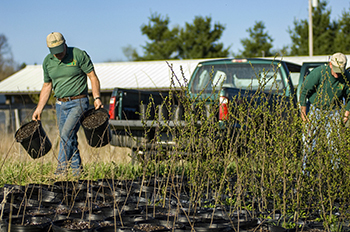
?We created some of the highest-quality sustainable turkey hunting in the nation,? Stewart said. ?That says a lot when your competitors for that are places like Missouri, that is the best wild turkey habitat in the world and the highest population. They don?t have deep snow.?
The DNR?s habitat improvement work in recent years has included projects like creating Michigan?s Turkey Tracts, public hunting areas with habitat intensively managed for turkeys. There are now five Turkey Tracts locations, in Allegan, Barry, Montcalm, Oakland and Tuscola counties.
?The program highlights areas of public land where the habitat has been intentionally managed for wild turkeys, creating great hunting conditions for new or seasoned hunters,? Adam Bump, the DNR?s current upland game bird specialist, said.
The National Wild Turkey Federation, at its annual Convention and Sport Show in Nashville earlier this year, presented the Michigan DNR with its Land Stewardship Award, which honors companies and/or government agencies that promote wildlife habitat management.
?Michigan DNR is at the forefront of keeping managed public lands open to the public, while maintaining high-quality habitat on these managed areas. The agency has a long history of collaborating with other state and federal agencies in larger landscape efforts to manage the public lands in Michigan. Moreover, the department has a long history of partnering with non-governmental organizations like the NWTF to accomplish habitat?restoration and conservation projects on its lands,? read a NWTF news release about the award.
|
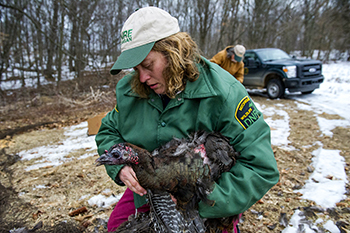
Scott Whitcomb, director of the DNR Office of Public Lands, accepted the award ?on behalf of the DNR and the passionate sportsmen and women who contribute to and benefit from this effort.?
"In Michigan, we're blessed with an abundance of natural resources and wild places you don't come across every day, providing the backdrop for hunting, fishing and all types of outdoor recreation and relaxation. This award recognizes sound, strategic stewardship of 4.6 million acres of state-managed land in Michigan, an achievement that would not be possible without conservation partners like the National Wild Turkey Federation.?
In addition to the 4.6 million acres of DNR-managed public land open to hunting, millions of additional private-land acres are leased or enrolled in programs to allow hunting for all. Visit Michigan.gov/Hunting for more information about where to hunt.
Hunters made it possible
The DNR and partners like the NWTF put in the work behind the wild turkey?s comeback, but it would not have been possible without hunters.
|
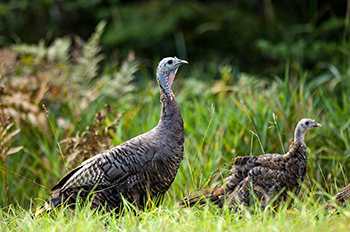
Revenue to fund wild turkey management efforts ? for the past several decades, now and into the future ? comes directly from the sale of hunting licenses and equipment.
The Michigan Game and Fish Protection Fund, funded primarily through hunting and fishing license fees, is the DNR?s largest revenue source and is critical to its conservation work.
And since 1937, when Congress passed the Federal Aid in Wildlife Restoration Act (also known as the Pittman-Robertson Act), states have received funds from manufacturer taxes on ammunition, firearms and archery equipment?for wildlife restoration.?These funds are distributed to the states based in part on the number of hunting licenses each state sells.
After passage of this groundbreaking legislation, conserving wild turkeys and other wildlife gained nationwide support and habitat management began.
?Sportsmen and women play an essential role in conservation efforts throughout the country,? said Rebecca Humphries, co-CEO of the National Wild Turkey Federation. ?Many people don?t realize, including some hunters and anglers, that the sale of licenses and equipment ? not state tax dollars ? are the primary source of conservation funding for Michigan and other states.?
So, while the turkey on your Thanksgiving table may not be a wild one, take a moment to raise a glass to its feathered brethren in the wild and the conservationists and hunters who engineered their comeback.
Read a sidebar story with fun facts about wild turkeys, and learn more about turkeys and turkey hunting at Michigan.gov/Turkey.
|
Check out previous Showcasing the DNR stories in our archive at Michigan.gov/DNRStories.?To subscribe to upcoming Showcasing articles, sign up for free email delivery at Michigan.gov/DNREmail.
Note to editors:?Contact:?John Pepin, Showcasing the DNR series editor, 906-226-1352. Accompanying photos and a text-only version of this story are available below for download. Caption information follows. Credit Michigan Department of Natural Resources, unless otherwise noted.
Text-only version of this story.
Text-only version of sidebar story.
1980s: Wild turkeys from Iowa are released in Clinton County as part of the southern Michigan wild turkey restoration program in the 1980s. Pictured are retired Michigan Department of Natural Resources upland game bird specialist Al Stewart (in green) and some of the partners involved in the project.
Award: Earlier in 2022, the National Wild Turkey Federation presented the Michigan Department of Natural Resources with its Land Stewardship Award, which honors companies and/or government agencies that promote wildlife habitat management. Pictured, left to right, are NWTF regional biologist Ryan Boyer; Scott Whitcomb, director of the DNR?s Office of Public Lands, who accepted the award; and NWTF CEO Becky Humphreys. (Photo credit: Lexi Kelly)
Backyard: Today, wild turkeys are a common sight in Michigan, but in the first half of the 20th century, they had disappeared from the state.
Driveway: Dozens of wild turkeys gather in a driveway in Dickinson County on a cold winter morning. The family living here was feeding the birds. The feeding of turkeys has helped widen their geographic distribution.
Habitat: The Michigan Department of Natural Resources has partnered with the National Wild Turkey Federation on many wild turkey habitat improvement projects. Here, crabapple trees are repotted for planting at Rose Lake State Wildlife Area in Clinton and Shiawassee counties.
Hunters1 and Hunters2: The wild turkey?s comeback would not have been possible without hunters, as revenue to fund turkey management efforts comes directly from the sale of hunting licenses and equipment.
Male: Male turkeys have spurs on their legs, which get longer as they age and are used to grapple with other turkeys over breeding rights, and a ?beard,? which looks like a miniature horse?s tail, on their chest.
Release1 and Release2: Releases of wild turkeys in Michigan have aided greatly in efforts to re-establish the species. Pictured here is a project to trap and relocate turkeys from Barry State Game Area in Barry County to the Baldwin area in Lake County.
Tract: A successful hunter displays the turkey he shot at one of Michigan?s Turkey Tracts, public hunting areas where habitat is intensively managed for wild turkeys.
Turkeys1 and Turkeys2: Once a declining species in Michigan and across the country, wild turkeys now can be found in all counties in the Lower Peninsula and in some parts of the Upper Peninsula.
|